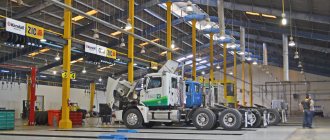In modern economic conditions, characterized by crises in various industries, sanctions restrictions and exchange rate fluctuations, many organizations are puzzled by the issue of increasing the efficiency of their operating activities. To this end, they first seek to influence their expenses, trying to maintain income at least at a stable level. And for most of them, it becomes important to answer the questions: where to start the process of reducing costs and what results to expect? How to develop and use an integrated approach, rather than focusing on individual actions (for example, reducing personnel and/or their income)? How to take into account the features and interrelationships of an organization’s business processes? How to organize a long-term cost reduction effect?
Solving the problem of reducing costs in an organization begins with a general analysis of the economic situation. Having generated reports (accounting, management), managers of an organization, as a rule, seek to understand whether the resulting level of expenses is acceptable or excessive for it.
Tools used for cost analysis
What tools do managers use? Widely used:
1. Methods for analyzing the behavior of costs (and their structure) depending on the volume of output (example: the cost-volume-profit method - CVPAnalysis).
2. Methods for comparing the received costs with the costs taken as a benchmark for achieving a certain result (example: method of variance analysis, benchmark - budget/plan indicators).
3. Methods for comparing received costs with similar costs of the same organization for other (comparable) periods (example: horizontal analysis method).
4. Methods for comparing the dynamics of the shares of received costs with the shares of other (not necessarily similar) costs of the same organization for the same periods (example: vertical analysis method).
5. Methods for comparing the received costs with similar costs of another organization (organizations) operating in the same market (example: benchmark analysis method).
There are also other methods of cost analysis (for example, statistical methods), and in each specific situation, managers of the organization can also use them for their own purposes. But it is important that, as a result, the general analysis should reveal what costs the organization bears (volume, types), how these costs behave (dynamics) and who/what is the source of these costs (division/asset/business process).
We determine the cost structure and decompose it
Then it is advisable to determine the cost structure (the percentage of individual types of costs in the overall “pie”). Thus, managers of the organization will be able to understand what shares are occupied by certain types of costs and which costs dominate in the organization.
In a certain cost structure, it is necessary to identify the most significant costs. Why is it important? Because significant costs significantly affect the economic position of the organization. In the economic/expense structure of each organization, as a rule, the costs that are significant for it are clearly visible, that is, the costs with the largest share, significant volume and, possibly, with pronounced dynamics. Thus, the organization's managers get an idea of the costs that are prioritized for detailed analysis and further minimization.
The resulting significant costs must be divided into individual components (decomposed). As a result, managers will be able to influence these parts to most effectively influence the whole. Decomposition will allow you to replace the solution of one large problem with the solution of a series of smaller problems, interconnected and simpler.
We formulate an item-by-item reduction plan
Having received a complete picture of significant costs and their components, it is necessary to move on to drawing up an item-by-item cost reduction plan. To compile it, it is necessary to conduct an audit of possible methods for reducing identified significant costs (including their components) and then formulate item-by-item quantitative goals for such reduction, also determining the time for achieving the goals.
Possible cost reduction methods include:
1) an absolute reduction in the value of fixed and/or variable costs by the internal forces of the organization without a significant change in the business processes of the organization itself (for example, an administrative decision to reduce staff salaries by 10%);
2) partial or complete change in the type of costs: transfer of costs from fixed to variable (for example, an increase in the proportion of bonuses in the overall structure of staff income (less fixed costs, more variable));
3) replacement of costs with smaller ones provided by a third party (outsourcing);
4) making investment decisions leading to the introduction of new equipment, the use of new technologies (including the development of our own R&D sites);
5) changing the organization’s internal business processes, leading to cost reduction (for example, the introduction of a single remote call center, which increases the productivity of customer service and reduces costs for personnel and premises);
6) agreements with external contractors of the organization (suppliers, financing organizations, authorities, etc.).
Based on the practice of reducing costs and applying the described cost reduction algorithm, in the vast majority of organizations several cost items prevail, totaling more than 2/3 of the total costs. These types of costs include the following groups (arranged conditionally, in relation to the key factor, and not to the name of a specific cost item), associated with:
- raw materials and materials;
- goods for resale;
- staff;
- real estate;
- transport;
- information technologies.
An exception may be organizations with developed (due to technological necessity) heat and/or electricity (usually large manufacturing enterprises). The above grouping allows organizational managers to use the tools they know to influence individual components for an overall cost reduction.
Factors for reducing production costs
Many factors influence cost reduction. Conventionally, they can be divided into the following:
- Intra-production – those that enterprise managers can directly influence. These include: staff reduction, automation of individual processes, staff motivation, etc.
- Non-production - those that cannot be influenced by the enterprise. These are the cost of fuel, raw materials, tariffs, the amount of tax deductions, etc.
We put the plan into action
The final step of the algorithm for reducing costs in an organization is the implementation of an action plan to reduce costs. To successfully implement the plan, it is necessary to resolve issues of the team (performers), resources (material/labor), time (deadlines). Depending on how these issues are resolved by the organization's managers, there are three main ways to implement the plan.
1. Administrative implementation.
- Team: heads of the departments involved.
- Resources: labor only.
- Deadlines: as short as possible.
2. Project implementation.
- Team: key employees of the Central Federal District.
- Resources: labor, possibly material.
- Terms: no more than one year.
3. Implementation by creating a permanent body as part of the organizational structure.
- Team: key employees of the Central Federal District/dedicated unit (body).
- Resources: labor and material.
- Time frame: more than one year.
Example of using the algorithm
Let's consider the practical use of a cost reduction algorithm in a manufacturing enterprise.
In a vertically integrated group of companies, consisting of several plants (mining and processing) operating in the eastern part of the country, and a management company (MC) located in Moscow, the task was set to reduce costs. Commodity markets at this moment were characterized by high prices for petroleum products and strong price volatility.
The task was posed as follows:
- reduce total (fixed, variable) costs at the management company level by the maximum possible amount (minimum 5%) compared to the previous year;
- identify all the main items to reduce overall costs at the holding’s enterprises (not affecting uninterrupted operations and production safety). In the second quarter, we will begin to reduce them, as well as develop a program to reduce the cost of the product line produced at the enterprises.”
To solve the latter problem, at one of the holding plants producing chemical raw materials for further processing, a horizontal and vertical analysis of the plant’s costs was first carried out (accounting and management reporting, production plans served as sources for this). As a result, it was revealed that the plant incurs quarterly costs of about $270 million (of which about 60% are fixed), costs tend to increase quarterly (5-10% growth every quarter), the main sources of costs are raw materials (for further redistribution into the enterprise's products), MTS supplies (to ensure production) and plant personnel.
The annual costs of the plant have the following structure:
- direct material costs (material costs) - 53%;
- direct labor costs - 12%;
- general production costs - 21%;
- commercial expenses - 9%;
- administrative expenses - 5%.
For the purpose of analyzing costs and further impact on them, the management company determined that items more than 5% are significant for the plant, because the volume of costs for each consolidated item is significant - several million dollars per month.
Thus, the following items became significant costs for the plant (ranked in order of importance for the enterprise):
- “Direct material costs”;
- "General production expenses";
- "Direct labor costs";
- "Business expenses";
- "Administrative expenses".
Decomposition of significant costs under the item “Direct material costs” showed that the main product of the analyzed plant is chemical raw materials for further processing. This product and its varieties are produced as a result of a chemical reaction between the concentrate purchased within the holding (at a transfer price) and sulfuric acid (purchased both from external suppliers and produced at the plant from purchased sulfur).
Under the article “General production costs”, it turned out that, due to technological reasons, production is characterized by high energy intensity and significant costs for heat energy (maintaining set temperatures for the reaction, heating workshops and administrative buildings, heating process water).
The plant's staff consists of more than 7,500 workers, the average salary is 29,500 rubles. The structure of these costs:
- Staff salaries - 55%;
- bonuses, benefits, compensation - 21%;
- training - 6%;
- other costs - 18% (individual components less than 5% each).
The plant actively sells finished products around the world (the ratio of internal and external sales is 60/40), packaging its products in large plastic bags (big bags). Delivery is carried out both by rail and by sea; in international trade, transshipment warehouses abroad are actively used.
The costs associated with the administrative support of the main activities of the enterprise are quite numerous and dispersed in composition - among all their components there is no strong dominant.
Based on the data received, the management company developed an action plan to reduce costs (item by item).
Direct material costs:
- conducting negotiations with suppliers of sulfur and sulfuric acid on the possibility of reducing prices for wholesale supplies, holding tenders;
- development of an investment project to modernize the sulfuric acid workshop of the plant (one liter of sulfuric acid purchased from external suppliers is 10-15% more expensive than that obtained at the plant, while the equipment of the workshop is outdated and does not allow increasing production volume);
- conducting an audit of prices for all other materials consumed in the production of the main product, tenders;
- conducting a technology audit and developing measures to optimize key business processes and optimize the technological cycle (if possible).
Notes: the transfer price of the concentrate has no potential for reduction, since it is purchased within the holding from the mining enterprise and it sells it with a minimal margin.
General production expenses:
- participation in the annual regional electricity price compensation program;
- development of an investment project for alternative sources of domestic heat energy;
- development of an investment project to save heat energy;
- conducting negotiations with fuel oil suppliers on the possibility of reducing prices for wholesale supplies, holding tenders;
- audit of prices for machines and equipment, used tools, consumables, holding tenders.
Direct labor costs:
- based on the results of a technology audit, development of measures to optimize key business processes: establishing the possibility of optimization/redistribution of working personnel.
Note: most of the components of this article do not have significant reserves for reduction, because are already at a fairly low level.
Business expenses:
- conducting an audit of prices for transport, warehouse and marketing services, holding tenders with possible suppliers;
- holding tenders with possible suppliers of packaging (big bags);
- conducting an audit of auxiliary business processes and developing measures to optimize them;
- conducting additional analysis of other costs and determining the possibility of reducing costs for smaller cost items.
Administrative expenses:
- conducting an audit of the costs of maintaining buildings/structures, holding tenders with possible alternative providers of operating services;
- analysis of the use of premises and disposal of rented surplus, negotiations with tenants to reduce rental rates;
- analysis of the use of the administrative fleet, reduction in the number of personal (assigned) cars, transition to fuel cards for corporate fuel payments;
- analysis of other transportation costs of the administration, use of more economical tariffs and service providers;
- analysis of communication and Internet tariffs used, holding tenders;
- conducting an audit of auxiliary business processes and developing measures to optimize them (in relation to the administrative activities of the enterprise);
- conducting additional analysis of other costs and determining the possibility of reducing costs for smaller cost items.
Improving communication efficiency
A significant proportion of small and medium-sized businesses do not use electronic organizers for setting tasks and monitoring implementation, or an electronic document management system. Moreover, sometimes employees do not use email, and reports are prepared in paper form.
Of course, all this reduces the effectiveness of communications and does not allow measuring the performance discipline of employees, and therefore, managing it. Enterprises with poorly established communications have large reserves for reducing costs.
As doctors say, “there are no healthy people, only those who have not been thoroughly examined.” Also on the issue of reducing costs: there are no enterprises that do not have reserves . There are enterprises that do not notice their opportunities to improve efficiency.
To formulate a work plan to reduce costs, a management audit . On our website you can find out how to order a management audit and see examples of business diagnostic reports . In the section “Cost of enterprise management diagnostics,” we wrote about how to optimize the costs of this procedure. If you are interested in the cost and timing of this work for your company, fill out this form and we will prepare for you a commercial proposal that takes into account the possibilities of such optimization.
Implementation of a cost reduction plan
This stage was carried out taking into account the limitations of the task (to apply measures that “do not affect the uninterrupted operation and safety of production”). Based on this, quick but insufficiently developed measures could carry additional risks both for the enterprise and for the holding as a whole. In this regard, it was decided not to apply operational administrative measures at the enterprise level, but to focus on project implementation and the creation of a cost management committee.
Project implementation
Based on the results of identifying the necessary actions to reduce costs in the organization, a project team was created, consisting of key employees of the main blocks of the enterprise (administrative, production, financial, commercial), which over the course of two quarters implemented the following priority actions (indicating the achieved effect):
1) direct material costs were reduced by $333,900 per month due to agreements with current suppliers:
- on reducing the selling price for sulfur and sulfuric acid by 2%;
- on reducing the selling price of other materials (consumed in the production of the main product) by a total of 1.5%;
2) general production costs were reduced by $157,100 per month due to:
- participation in the annual regional program for compensation of electricity prices by 5%;
- agreements with the current fuel oil supplier to reduce the selling price by 1%;
3) business expenses were reduced by $51,840 per month due to:
- agreements with current transport service providers to reduce prices by a total of 2%;
4) administrative expenses were reduced by $11,925 per month due to:
- agreements with the current landlord to reduce rental costs for some properties by a total of 2%;
- reducing the number of personal (assigned) cars, switching to fuel cards for corporate fuel payments and using more economical tariffs and transport service providers by a total of 1%;
- use of more economical communication tariffs (including international and long-distance) and Internet by 0.5%.
The team also developed and proposed the following investment projects to the holding’s management:
- to modernize the sulfuric acid shop of the plant (the expected effect is a reduction in costs for sulfuric acid by 80%, an increase in production volume by 50%);
- for the construction of a coal boiler house with the purchase of coal at a transfer price within the holding (the expected effect is a reduction in the cost of heating process water and heating by 10%);
- for the installation of new thermal insulation on the internal heating networks of the enterprise (the expected effect is a reduction in heat loss by 20%).
Creation of the Cost Management Committee
The organization created a cost management committee, consisting of managers of the main blocks of the enterprise (administrative, production, financial, commercial). The committee was supposed to analyze on an ongoing basis the total cost of manufactured products and within three months begin to systematically reduce it (over the horizon of 1-3 years, reduce the total cost by at least 10%). The main tools of the committee:
- regular holding of tenders (primarily for costs noted in the actions);
- conducting an in-depth technological audit of the enterprise and introducing measures that optimize the technological processes of the enterprise and reduce production costs.
Results:
1) priority actions have been implemented with a total effect of 0.6% of the enterprise’s monthly costs;
2) three investment projects have been developed that can bring the enterprise a total effect of at least 5% of total costs;
3) two analytical projects were initiated to optimize the main and auxiliary business processes, which can bring the enterprise a total effect of up to 5%;
4) a process has been initiated to reduce the cost of manufactured products, which in the next 1-3 years can bring an effect of at least 10% of the original total cost.
Thus, the task set to identify the main items to reduce overall costs at the enterprise level, as well as to begin work to reduce them, was completed.
Where to start optimizing your cost management system
Optimization of the cost management system should begin with an analysis of the cost structure of production or the costs of individual divisions of the company. At the same time, analysis of cost calculation when distributing expenses between departments under the company’s current accounting system may turn out to be ineffective. In this regard, most companies keep track of their costs by activity.
When comparing the cost of indicators with competitors, you should pay attention to the following financial factors:
- economies of scale - a company can reduce costs when expanding production by distributing fixed costs;
- experience - knowledge accumulated over the years provides an opportunity to increase business efficiency;
- efficient use of capacity - investment in production will be limited if production capacity is used at full capacity;
- communications - an increase in expenses in one area does not lead to low efficiency of the enterprise;
- relationships - the ability to share costs through distribution between several departments;
- integration - the company independently performs work previously outsourced to contractors;
- timeliness - the company that entered the market earlier has a financial advantage;
- location - costs increase when functional units are located remotely relative to each other;
- external factors - tax rates, federal, regional regulation, etc. can give the company a financial advantage;
- marketing strategy - it is possible to reduce the factors influencing the increase in the usefulness of the product, however, they are compensated by the sale of the product.
Thus, we see that the optimization of an organization’s cost management is influenced by a large number of different factors, both external and internal, which must be taken into account when developing a cost management system.
Top 3 articles that will be useful to every manager:
- Financial control at the enterprise
- Net profitability of the enterprise
- How to build a company's financial structure











